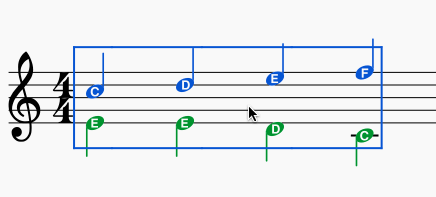符头样式
You can choose choose any one of nine notehead schemes for a standard staff. To set a notehead scheme:
- Right-click on a staff and select Staff/Part Properties…; click on Advanced Style Properties… and choose from the "Notehead scheme" dropdown list.
The schemes are as follows:
- Normal: This is the default scheme and the one the vast majority of people will use: it is also the only scheme in MuseScore 1 and 2. It uses normal noteheads which can be changed via the Noteheads palette or the Inspector.
- Pitch name: Noteheads automatically and dynamically change to include the English pitch name in the notehead.

- German pitch name: Just like the previous one but B will be replaced by H, and Bb by B.

- Solfège Movable Do (also called Tonic Solfa): Noteheads include the solfege syllable, depending on the degree in the scale. It uses Ti and not Si.

- Solfège Fixed Do: Noteheads include the solfege syllable for the note name. As used in France, Italy, Spain, etc... It uses Si and not Ti.

- 4 Shape (Walker): Noteheads follow the four-shape system used in books such as William Walker’s Southern Harmony (1835).

- 7 Shape (Aikin): Noteheads follow the seven-shape system used in books such as Jesse B. Aikin’s The Christian Minstrel (1846), and books by the Ruebush & Kieffer Publishing Company. It's the most used 7-shape system.

- 7 Shape (Funk): Noteheads follow the seven-shape system used in books such as Joseph Funk’s Harmonia Sacra (1851).

- 7 Shape Walker: Noteheads follow the seven-shape system used in books such as William Walker’s Christian Harmony (1867).

(For more info about the different variant of shape notes, see the SMuFL specification)
The setting applies to a given staff and the notehead will be used when entering and editing notes. Here is an example.

符头
A range of alternative noteheads "can be accessed via the 符头 palette of the Advanced workspace, or the 检视器 (see 更换符头组,见下文).
注意:The design of the notehead may vary depending on the music font selected (Emmentaler, Gonville or Bravura). Those in the palette are displayed as half notes in Bravura font.
符头组
MuseScore supports a range of notehead styles:
- 普通: A standard notehead.
- Crosshead (Ghost note): Used in percussion notation to represent cymbals. It also indicates muted and/or percussive effects in stringed instruments such as the guitar.
- 菱形: Used to indicate harmonic notes in instruments such as the guitar, violin etc.
- 斜杠: Used to notate rhythms (e.g. guitar strums).
- 正/倒三角: Used in percussion notation.
- Shape notes: Do, Re, Mi, Fa, Sol, La, Ti.
- Circle cross: Used in percussion notation.
- 带圈符头
- Slashed notehead: A notehead with an oblique line through it.
- Plus noteheads
- Alt. Brevis: Used in early music notation.
- 带括号符头 (Parentheses): applied around an existing note (or accidental).
更换符头组
要更改乐谱中一个或多个符头的外观,请使用下列任意办法:
- Select one or more notes and double click a notehead in a palette
- Drag a notehead from a palette onto a note in the score.
- Select one or more notes and change the notehead in the Inspector, using the drop-down list under Note → Head group (not supported for drum staves).
Change notehead type
Occasionally you may need to change the apparent duration of a notehead—i.e. notehead type—without altering its actual, underlying duration:
- Select one or more notes.
- Chose one of the following options from the Inspector under Note → Head type:
- Auto: Automatic, i.e, apparent duration = actual duration.
- Whole: Whole notehead, regardless of actual duration.
- Half: Half notehead, regardless of actual duration.
- Quarter: Quarter notehead, regardless of actual duration.
- Breve: Breve notehead, regardless of actual duration.
Shared noteheads
When two notes in different voices, but of the same written pitch, fall on the same beat, one of two things may happen:
- The notes may share the same notehead.
- The notes may be offset: i.e. arranged side by side.
MuseScore follows standard music notation practice as follows:
- Notes with stems in the same direction do not share noteheads.
- Dotted notes do not share noteheads with undotted notes.
- Black notes do not share noteheads with white notes.
- Whole notes never share noteheads.
Note: If two unison notes occur in the same voice they are always offset.
Change offset noteheads to shared
Offset noteheads can be turned into shared noteheads in one of two ways:
- Make the smaller-value notehead invisible by selecting it and using the keyboard shortcut V (or unchecking the "Visible" option in the Inspector).
- Alter the notehead type of the shorter-duration note to match the longer one by switching "Head type" in the "Note" section of the Inspector.
Examples of notehead sharing
-
In the first example below, the notes of voices 1 and 2 share noteheads by default, because they are all black, undotted notes:
-
By contrast, in the next example, white notes cannot share noteheads with black notes, so are offset to the right:
To create a shared notehead, make the black eighth note invisible or change its head type to match that of the white note (as explained above):
Remove duplicate fret marks
In certain cases, a shared notehead, when pasted to a tablature staff, may result in two separate fret marks on adjacent strings. To correct this, make any extraneous tablature notes invisible by selecting them and using the keyboard shortcut V (or by unchecking the "visible" option in the Inspector).
External links
- Shape notes at Wikipedia.
- Ghost notes at Wikipedia.